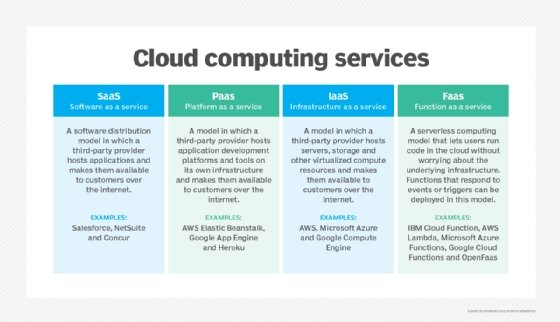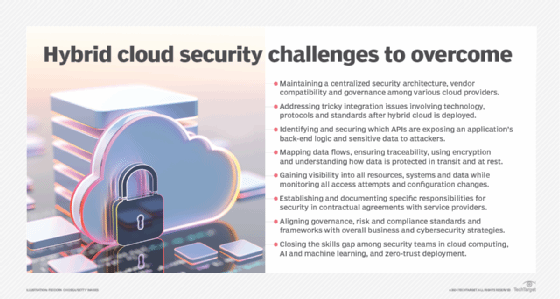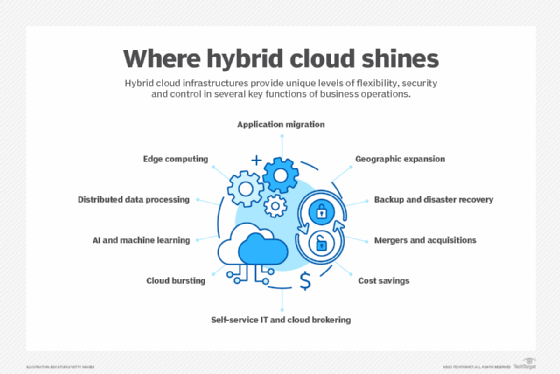On premises vs. cloud pros and cons, key differences
Immersed in the 'should I stay or should I go' cloud migration debate? Before vacating the premises and moving 'up there,' ponder these advantages and disadvantages.
With increasing pressure on businesses to digitally transform and remain competitive, migration of data, applications and workloads to the cloud has intensified for reasons of scalability, storage capacity and initial cost savings. And, for companies making plans or in the process of vacating the premises and moving "up there," the debate focuses on whether to deploy a public, private or hybrid cloud model.
The cloud can take on the persona of being all-powerful with seemingly infinite scale, countless tools and services, and a virtual army of technicians and support personnel. Migration might seem like the fashionable thing to do. But, despite its many benefits, cloud computing isn't the ideal solution for every problem or the right fit for every organization. Industries have different requirements for everything from security to reliability to budget. In some circumstances, it can be prohibitively expensive to move from a well-functioning on-premises system to the cloud.
When debating "should I stay or should I go" now and in the future, it's important to review the on-premises versus cloud pros and cons and the data, applications and workloads in question.
Advantages of on-premises infrastructure
On-premises infrastructures are physically located within an organization, hosted on-site and under the direct control of IT staff. Typically housed in the company's data center, these deployments have a number of potential advantages, including the following:
- Infrastructure control. When an organization owns the hardware and systems that underpin its IT infrastructure, it has total control over where those components live, how they run and who can access them.
- One-time costs. Companies can maintain a better grip on server, storage, networking and security expenses that are typically paid upfront without the recurring monthly costs for cloud services. Long-term costs for on-premises infrastructure can be lower for applications with predictable usage patterns. Once organizations buy the hardware, the only ongoing costs are power and maintenance.
- Security. The IT team's complete control of resources, services and data residing on their own servers includes data security. They decide how, when and why someone can access the company's hardware or network, enabling some organizations to better meet the regulatory requirements of numerous international, national and local data protection and privacy laws.
- Efficiency. On-premises system performance advantages include low latency and development environments with few or no external dependencies. The feedback loop between on-premises infrastructure changes and individual employees is short. And, if there's an outage, employees on-site can make adjustments as necessary.
- Internet-free access. No doubt, the internet is indispensable to any business. However, users don't need an internet connection to access data stored on premises, eliminating the fear of productivity loss due to an interruption in internet service.
Disadvantages of on-premises infrastructure
There can be a flip side to many of the on-premises advantages in terms of higher upfront costs, storage capacity, data backup capabilities and total ownership of regulatory compliance responsibilities. On-premises drawbacks include the following:
- Reliability. A company's infrastructure is only as reliable as its maintenance. A well-trained team must be in place to ensure everything runs in tiptop shape.
- Scalability. A fixed set of on-premises servers represents fixed resource capacity. When an organization needs more resources, the only option is to buy more servers. Few companies can build an internal infrastructure to match the scope and flexibility of a cloud provider's platforms and services.
- Ownership costs. When an organization purchases more servers to meet the need for more capacity only to see resource demands diminish, the additional capacity might be underused. Buying an extra server to accommodate a 5% increase in demand is not cost-effective.
- Maintenance. Since IT teams are responsible for their own on-premises hardware, maintenance requirements never end and can be lumped into ongoing costs.
- Security. Security is a double-edged sword. An on-premises arrangement grants far more control over the physical and network infrastructure, but the burden of security is high. Complex and interdependent systems increase the risk of human error, such as misconfigurations, that could potentially introduce security threats. Plus, many of today's security tools and architectures are best served in the cloud.
- Technical skills. On-premises infrastructure requires traditional IT skills, including hardware and software systems administration, networking, database management and security. Such a combined skill set can be difficult to find, and many of these skills are less applicable as enterprises shift workloads to the cloud and embrace DevOps methodologies.

Advantages of cloud computing infrastructure
Cloud infrastructures with their many platform options -- SaaS, PaaS, IaaS and FaaS (function as a service) -- provided by third parties have several advantages over on-premises architectures, including the following:
- Abstraction. Cloud computing models decouple computing, storage and networking resources from the actual hardware assets and, therefore, abstract away much of the technical systems management and expertise required of a traditional infrastructure. Cloud providers also abstract technical administration for security tasks and provide specialized cloud security tools to manage access controls, firewalls and vulnerability assessments.
- Backup and disaster recovery (DR). Cloud technologies enable cloud and managed service providers to create a facility dedicated to a range of effective backup and DR services and capabilities beyond traditional DR options.
- Scalability and storage. IT professionals and administrators can dynamically add and remove capacity and cloud resources as needed so capacity and resources don't go to waste. Less critical workloads can be stored on public cloud, freeing up on-premises storage for more critical and sensitive data and applications.
- Pay-as-you-go pricing. Costs for cloud-based applications are generally lower. Monthly costs are much lower when compared to large licensing fees for on-premises applications. In a composable infrastructure scenario, organizations pay only for the resources they use, rather than the resources they have. If they typically use less than their compute capacity, costs can be significantly reduced and result in more affordable overall costs.
- Uptime. When it comes to service disruptions, no cloud vendor can provide perfect uptime, but many providers guarantee at least 99.99% uptime.
- Easier and faster deployment. Cloud computing software and resources typically don't take long to install, a key asset especially when time is of the essence. Companies avoid the excess time and costs involved in long installations associated with on-premises infrastructures.
- Managed services. Cloud vendors typically offer management services, including hosting the software, purchasing the necessary hardware, making upgrades and monitoring networking operations.

Disadvantages of cloud computing infrastructure
Cloud computing benefits come with potential challenges, including the following:
- Reliability. Handing over control to a cloud provider also means relinquishing control over reliability. Cloud providers boast impressive uptime, but services occasionally go down. Even brief interruptions to cloud services can cause major problems for customers -- and there isn't much they can do but wait.
- Complexity. Cloud providers frequently expand their service portfolios. The more advanced a company's needs, the more complex it can be to select, implement and manage the appropriate cloud services.
- Efficiency. Application infrastructure that isn't designed for the cloud might not perform optimally. Internet connectivity and speed, permissions management and other factors can potentially reduce application efficiency.
- Less flexibility. Cloud-based software often comes as off-the-shelf, one-size-fits-all applications and, therefore, lacks flexibility and customizability.
- Vendor lock-in. The more a company uses cloud-based infrastructure from one provider, the greater the risk of vendor lock-in. It may be difficult to migrate to a different provider's infrastructure -- or even move back on premises.
- Cost management. If organizations aren't careful, they might inadvertently use more cloud services than planned. Huge upticks in resource requirements can quickly break the bank. Long-term subscription costs for cloud-based software can add up and may eventually exceed the cost of an upfront software licensing fee.
- Storage costs. The costs for housing applications in the cloud grow slowly and can accumulate unnoticed if not allocated and monitored properly. Plus, unused data residing in the cloud can bloat the monthly cloud storage bill.
- Specialized skills. Some traditional systems administrator skills may be less applicable in the cloud, and engineers need to master other cloud skill sets -- from utilizing identity and access management (IAM) to understanding the nuances behind countless services on the platform.
- Security. Migration and operation in the cloud come with inherent security risks. Though cloud security has improved, organizations need to ensure that cloud-based software packages support embedded security measures, like single sign-on and multifactor authentication.

On premises vs. the cloud: Key differences
Beyond the pros and cons of cloud-based and on-premises infrastructures, it's also important to understand the differences in how they operate. Key differences include the following:
- Deployment. Deploying software in the cloud or on premises is relatively the same -- but it's drastically different for hardware-based resources. When IT teams need an additional server in their data center, they order, rack, network and provision it. To spin up a server in the cloud, they simply press a button or run a few commands.
- Management. Cloud providers handle many of the management tasks, so users don't have to do much more than monitor and make adjustments through a management dashboard or software tools. An on-premises environment requires hands-on hardware maintenance, such as replacing drives, managing configurations, maintaining the network, handling power and even upkeeping the buildings that house it all.
- Security. Cloud providers handle most security requirements at the infrastructure level in a shared responsibility model, but it's up to users to properly configure and secure data and applications. In an on-premises environment, IT teams are solely responsible for software patches, OS upgrades and security configurations for applications and networks.
- Budgeting. Cloud-based instances are generally cheaper because users can pay for a fraction of a server and shut it down when they're done. But companies must carefully configure and monitor their cloud usage to avoid consuming more services than they planned and experiencing monthly sticker shock. On-premises pricing is fixed, but underused resources are financially wasteful. And investments in additional hardware to upscale capacity may take years to be cost-effective.
- Infrastructure. Cloud providers invest massive sums for infrastructure to support higher uptimes, faster response times and abundant resources. They control user access to their infrastructure. In an on-premises environment, IT teams own and control the infrastructure, but they're also limited by it and what they can acquire.
Choosing between cloud and on-premises infrastructure
The choice between cloud and on-premises infrastructure comes down to an organization's particular resources and business needs. It's important to ask the following questions:
- How much control is required? Consider how a cloud outage would affect the organization. If the company has mission-critical services that require high availability, determine how much risk the organization can live with depending on its internal capabilities. Cloud services can be configured with high reliability, such as redundancies across regions and availability zones. On-premises infrastructure almost always has a cap on this reliability and scalability.
- What are the cost tradeoffs? Determine the infrastructure's limitations, capabilities and -- perhaps most important -- costs when developing and running applications. It can be difficult to calculate and compare costs for on-premises versus cloud computing. Some investments require big upfront infrastructure costs, but they can become cost-effective over time. Many workloads make more sense to run in the cloud, but others do not. Big data analytics applications, for example, require transmitting, processing and storing vast amounts of data, and those requirements could make the cloud an expensive proposition.
- Who to trust? Security is a common concern when organizations evaluate on-premises and cloud infrastructures. Although companies can own and manage their security in an on-premises environment, cloud-based computing enables businesses to focus less on security and more on products and operations. On-premises infrastructure and cloud computing models deal with security in fundamentally different ways. IT teams are responsible for all aspects of security for on-premises infrastructure. Cloud providers abstract this away. In either case, it's important that companies carefully configure and manage their data and applications. While it may seem more secure to maintain physical control of the hardware, cloud providers likely have far more security expertise and resources than the company's staff possesses.
- What are the IT team's skills and strengths? Evaluate the team's expertise and the skills required for on-premises and cloud-based scenarios. While the cloud abstracts away many traditional on-premises IT tasks, it introduces the need for other skills, such as managing AWS IAM roles. Migrating to the cloud, for example, changes the company's network administration role.

Hybrid cloud: Best of both worlds?
Hybrid cloud infrastructures combine the strengths of on-premises, private cloud and public cloud resources. They often provide the flexibility, agility and scalability to move data, applications and workloads among distributed environments to meet changing computing needs, costs and regulatory requirements.
Hybrid cloud typically involves a connection from an on-premises data center to a public cloud. IT teams maintain control over the actual computing infrastructure and resources in-house for mission-critical data and applications and use public cloud services for workloads that are less critical and less sensitive.
With access to cloud-provided tools and applications, hybrid cloud might also be the most flexible and cost-effective architecture to absorb and apply advancements in generative AI, machine learning, automation, security and FinOps capabilities.
Zachary Flower, a freelance web developer, writer and polymath, strives to build products with end-user and business goals in mind and an eye toward simplicity and usability.
Ron Karjian is an industry editor and writer at TechTarget covering business analytics, artificial intelligence, data management, security and enterprise applications.






